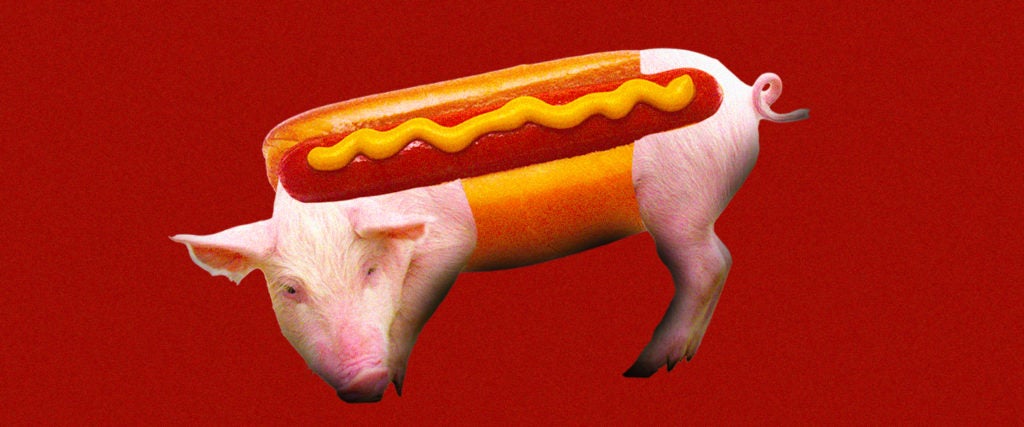With all due respect to the great American hamburger, the Fourth of July belongs to the humble hot dog.
Burgers are a part of everyday life, sold at fast-food windows and gussied-up gastropubs alike. Hot dogs, on the other hand, have a sense of occasion — it’s the thing you eat at the county fair, or while drunk on the sidewalk on a Saturday night, or, of course, at a baseball game.
That said, unlike the ol’ burger, the average American has no clue what goes into a hot dog.
The easy gag is that hot dogs are the platonic ideal of mystery meat, rumored to be made with lips and assholes and all sorts of heinous cuts that the average person can’t stomach. And the suspicion makes sense: Hot dogs have a unique texture and taste, unlike any kind of lean cut or even fresh sausage. It’s tube meat that seems closer to Spam than salami. “The more appropriate question is what aren’t hotdogs made of?” cracks one redditor, capturing something we’ve all thought to ourselves.
The reality is much more straightforward: Hot dogs are made with a mix of trimmings and mechanically separated meat (or “MSM”). The former is the byproduct of trimming the ugly bits off steaks, chops and other whole cuts of protein. The latter is a sort of meat pureé made by processing the bones that remain after butchering, using a press to literally strip all the meat off the bones. It might sound distasteful, but it’s found in all kinds of lunch meats (especially mortadella), cheap chicken nuggets and cafeteria burgers.
Cheaper hot dogs like good ol’ Oscar Mayers will use more MSM, while more quality franks often only use trimmings (this is what you get if the top ingredient in your hot dog reads “beef” or “pork”). Remember, that doesn’t include things like lips or offal cuts. It’s true that skin, fat and gristly parts (like, well, lips) can be used in a mechanically separated slurry, but the USDA only allows a hot dog to be made with 20 percent or less mechanically separated pork. That means there’s just not much in the way of snouts or lips to be had. Whatever goes in, the end product is always some indistinguishable smoothie of protein and fat, spiced heavily for flavor.
Perhaps this is all a relief to you — or maybe it just makes a hot dog seem grosser. Our cultural distrust of offal and the nasty bits makes it easy for people to assume that the hot dog is some Frankenstein’s monster, crafted by the meat industry so that it can con consumers and profit off low-quality crap. But I think our distrust of the humble hot dog is indicative of culinary weakness more than anything else. We saw this play out with the Great Pink Slime Fiasco a decade ago, when mainstream news outlets found out about a freaky-sounding meat filler that breathless reports claimed was potentially toxic and hidden in cafeteria meals.
Of course, the reality of that slime was far more banal, but that didn’t matter much to Americans who had gotten a gag-inducing taste of the realities of killing and eating ruminants en masse. I’d argue that in a different light, the mystery hot dog is a warrior against the scourge of endless food waste in this country. It’s almost too bad that hot dogs aren’t full of kidneys and ears, given that we waste a mountain’s worth of edible offal every year. Most of it is rendered to be used in soap and animal feed. And that’s a shame, because great cooks all over the world have historically used trimmings and offal to create delicious and iconic dishes.
The best thing I’ve ever eaten in Europe is a tete de veau that I found in a Paris bistro — a slab of calf’s head (including lip!), deboned and braised slowly until tender and fragrant, served with a warm vinaigrette. Oh, and remember pork bung? The (literal) asshole that went viral when Ira Glass and This American Life whipped up the urban legend that cheap calamari was actually pig ass? I’ve eaten it, not as calamari but as itself, grilled on skewers and dipped into a sauce of spiced vinegar and soy sauce. (It’s incredible beer food.) The late, great Jonathan Gold sure extolled the virtues of tender beef-lip tacos, which are shockingly easy to make at home, provided you can find some lips.
Hell, the entire world of charcuterie exists to use off cuts and fatty bits.
The real question here isn’t whether hot dogs have lips or rectum in them, but rather why we care so much at all. In my mind, the only rule of hot dogs is that the best ones have an extra dose of intestines — in the form of a perfect natural casing to crisp up on the grill.

